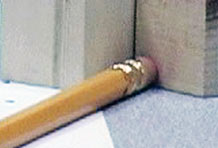Do very tiny things have weight?
4. Make meaning
Purpose of the discussion
This discussion will bring forward the idea that a piece of a material can be so small you can't "feel" any weight - and it may not even register weight on a balance scale - but it still has a place on the weight line. It has weight. You can probe what students mean when they say something "doesn't weigh anything:" do they mean they can't feel or sense any weight or that it weighs nothing and, therefore, shouldn't have a place on the weight line? This discussion can also bring forward evidence from this class that tiny things have weight: if you collect lots of tiny pieces, at some point when there are enough of them, you can "feel" their weight - this suggests that each tiny piece must contribute to the weight of the collection.
Revisit the list of properties used to sort
Return to the idea that (if you can imagine having the right tools) you could keeping cutting pieces of plastic modeling clay in half over and over again and putting these smaller and smaller pieces on the weight line.
Engage students in the focus question
Do tiny things have weight?
There's a difference between an object being so small you can't feel any weight and actually weighing nothing.
- We found that even teeny, tiny pieces have a place on the weight line (evidence from their investigation) so tiny things have weight (reasoning).
- If it's matter, even just a tiny bit, it has to have weight (reasoning).
If you gather up enough tiny pieces and add them together, the collection will weigh something, therefore, each piece weighs something.
- We started with 8 grams of plastic modeling clay, divided the pieces in half over and over again into lots of tiny pieces that didn't feel as if they had weight. If we collected all the pieces and smooshed them into a ball, the ball would weigh 8 grams.
We decided there is a place on the weight line for any piece of plastic modeling clay even if it's very, very small.
- The smaller the piece, the closer to zero on the weight line. You can't have something on zero (nothing) or on the other side of zero (you can't have negative matter).
Supporting questions
- If you keep cutting the plastic modeling clay pieces in half, will you ever get to zero on the weight line?
- No, you can't have zero material, although the pieces get closer to zero on the weight line the smaller they get.
- Can an object have weight if we can't feel it in our hands?

- Ask students to imagine using a pencil eraser so much that the whole eraser becomes a pile of tiny eraser rubbings. If you saved every tiny piece of rubbing and piled them together, would they have the same weight as the original eraser? If each tiny rubbing had zero weight, how could there be any weight when you pile them all together? Where would that weight come from? Isn’t the eraser like a collection of eraser rubbings all melted together?
- If a ball of string has weight, does 1 inch of string have weight? Does half an inch? How about a quarter–inch? Do all the pieces added together have the same weight as the original ball of string? If students had cut up the whole 8 grams of plastic modeling clay into teeny, tiny pieces, would all the tiny pieces together weigh 8 grams? If not, what happened to the weight?
Recap the discussion
Summarize the idea that our hands (and even balance scales) are not all that good at sensing small amounts of weight or small differences in weight. Students have experienced this when they used felt weight to order the cubes. Now we are gathering evidence that objects or small bits of material can have weight even if we can't feel it. Sensing weight is limited by our hands or instruments, not by the size of the particle.





